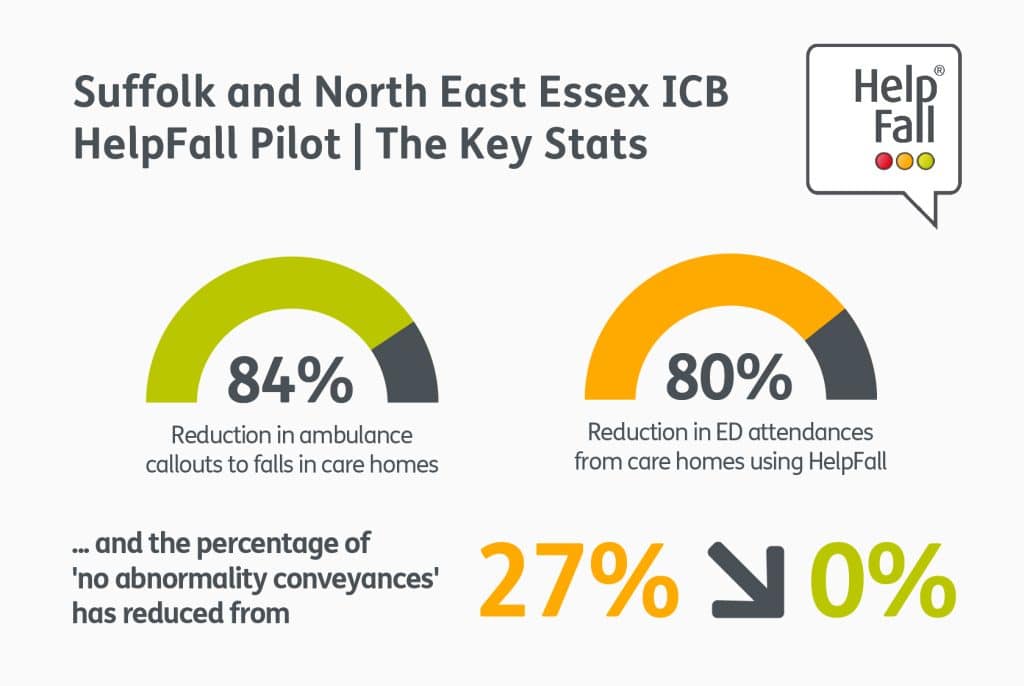Is HelpFall proven?
Considering HelpFall is a relatively new tool, we understand you may be concerned as to whether the tool is proven, and whether you are likely to see positive results through implementing it.
In this article, we aim to answer the question; Is HelpFall proven?, diving into where HelpFall is currently being used, HelpFall’s accreditations, and the results organisations are seeing through implementing HelpFall.
Where is HelpFall currently being used?
HelpFall is currently being used by care homes, response services, and domiciliary care organisations across the country.
Several ICBs have implemented HelpFall across care homes in their regions, including Suffolk and North East Essex ICB, Northamptonshire ICB, Devon ICB, and Hampshire and Isle of Wight ICB.
To read more about specific projects where HelpFall has been used and the impact it is having, follow the below links:
| Dom Care: How Ashley Care is improving falls outcomes in the community through using HelpFall and Raizers |
| Care Homes: How HelpFall Is Transforming Post Falls Management In Care Homes | The SNEE ICB Story |
What is HelpFall achieving?
For care homes
HelpFall is upskilling and empowering care home staff to safely assess and respond to falls, giving staff confidence that they are doing the right thing for each patient. The HelpFall reporting system gives care homes and staff the extra peace of mind that their decision-making has been recorded
HelpFall’s visual traffic light helps care staff quickly determine the level of risk associated with a fall, guaranteeing the appropriate response for each patient.
“[The staff] are more confident in handling a fall. They can just get HelpFall, and they can follow the instructions – it’s almost like there’s a little bit of pressure that’s been released from them.”
Kate Perkins, Deputy Manager | Milton Lodge Care Home
For domiciliary care organisations
HelpFall is enabling Domiciliary Care organisations to expand their services and upskill their staff to offer de-risked falls response in the community.
This is improving outcomes for individuals that fall and enabling fallers to stay in their own homes, as well as reducing ambulance callouts to falls, taking the burden of minor and non-injury falls off emergency services and enabling the ambulance service to improve their response times to higher-priority calls.
“The impact that this project has made on Ashley Care is incredible! We have been able to lift on average, 3 people per week for the last 6 months. This has led to a reduction in hospital admissions, decreased pressure on the ambulance service, and a decrease in disruption to our service.”
Charles Cross, Director, Ashley Care
For the patients
For the patients that experience falls, HelpFall is ensuring that the outcome of their fall is the best it can possibly be.
By guaranteeing the most appropriate response and next steps, HelpFall greatly reduces the risk of a patient unnecessarily waiting for an ambulance and experiencing a ‘long lie’, reducing the risk of the patient developing further injuries and complications.
Related article: What Is A Long Lie Fall? Causes, Impact, and Prevention
For the NHS as a system
Where HelpFall has been implemented, there has been reductions in the number of ambulance callouts to falls, which is freeing up the ambulance service to improve response times to category 1 and 2 callouts and reduce handover delays.
ICBs have also seen a reduction in no-abnormality conveyances, through implementing HelpFall in care homes. No-abnormality conveyances are unnecessary conveyances to hospital where there are no injuries or complications apparent, typically as a result of an unnecessary ambulance call-out due to a failure to suitably assess a fallen person before calling 999, costing the NHS precious time and money that could be spent on more urgent calls.
Below are some key stats from the Suffolk and North East Essex ICB HelpFall implementation:

Is HelpFall accredited?
HelpFall is based with permission on South Western Ambulance Service’s Post Falls Guidance Pack for Care Providers, giving it a strong clinical foundation.
HelpFall is also compliant with a number of standards and regulations, including ORCHA, DTAC and NHS Digital DSPT.
In a separate blog article, we cover all of the regulations HelpFall is compliant with, and why this matters. You can read this here.

Related articles
How does HelpFall de-risk falls response?
What regulations does HelpFall comply with?
How Do ICBs Implement HelpFall And The Raizer Lifting Chairs?
Get in touch
Got a question or want to send us a message? Let’s talk.